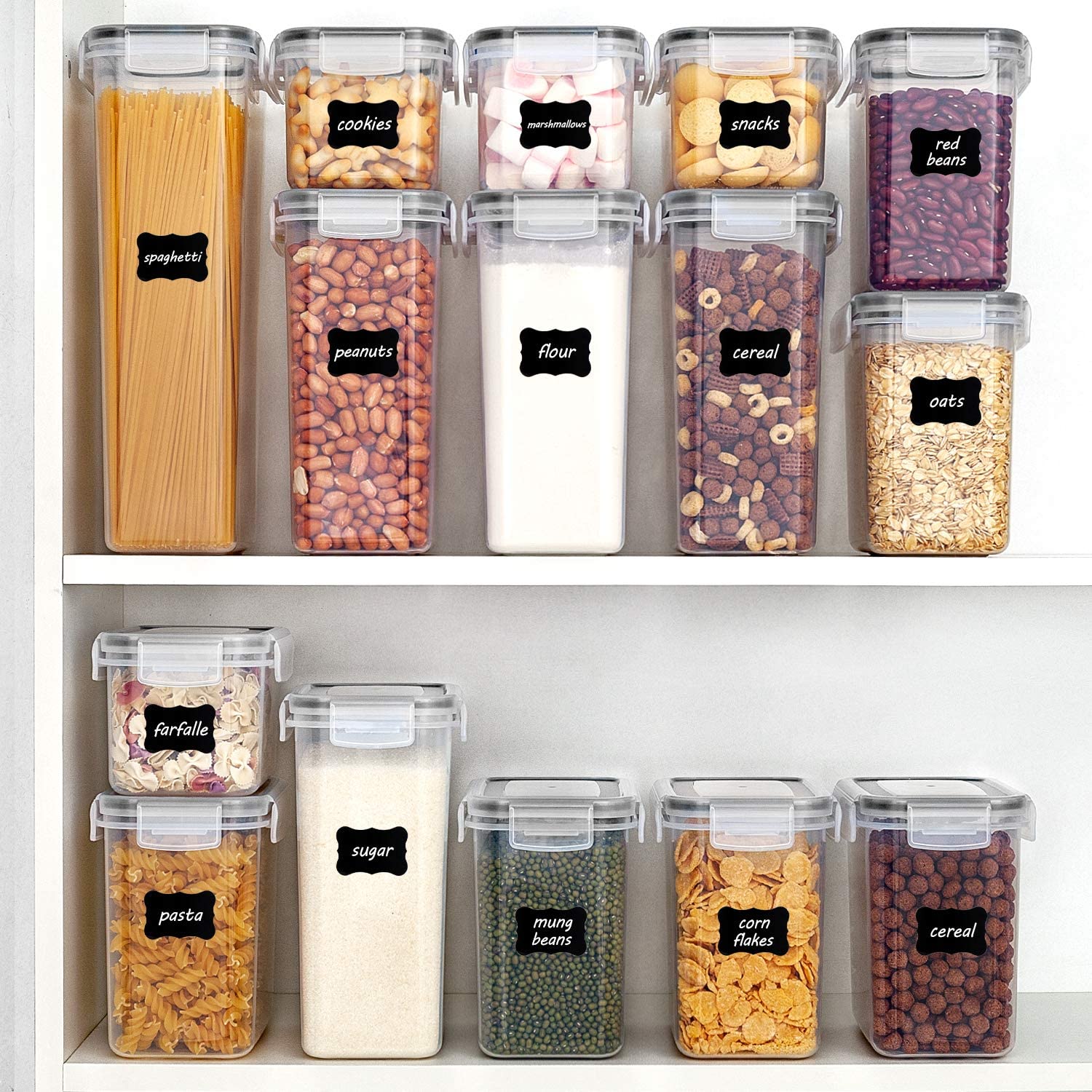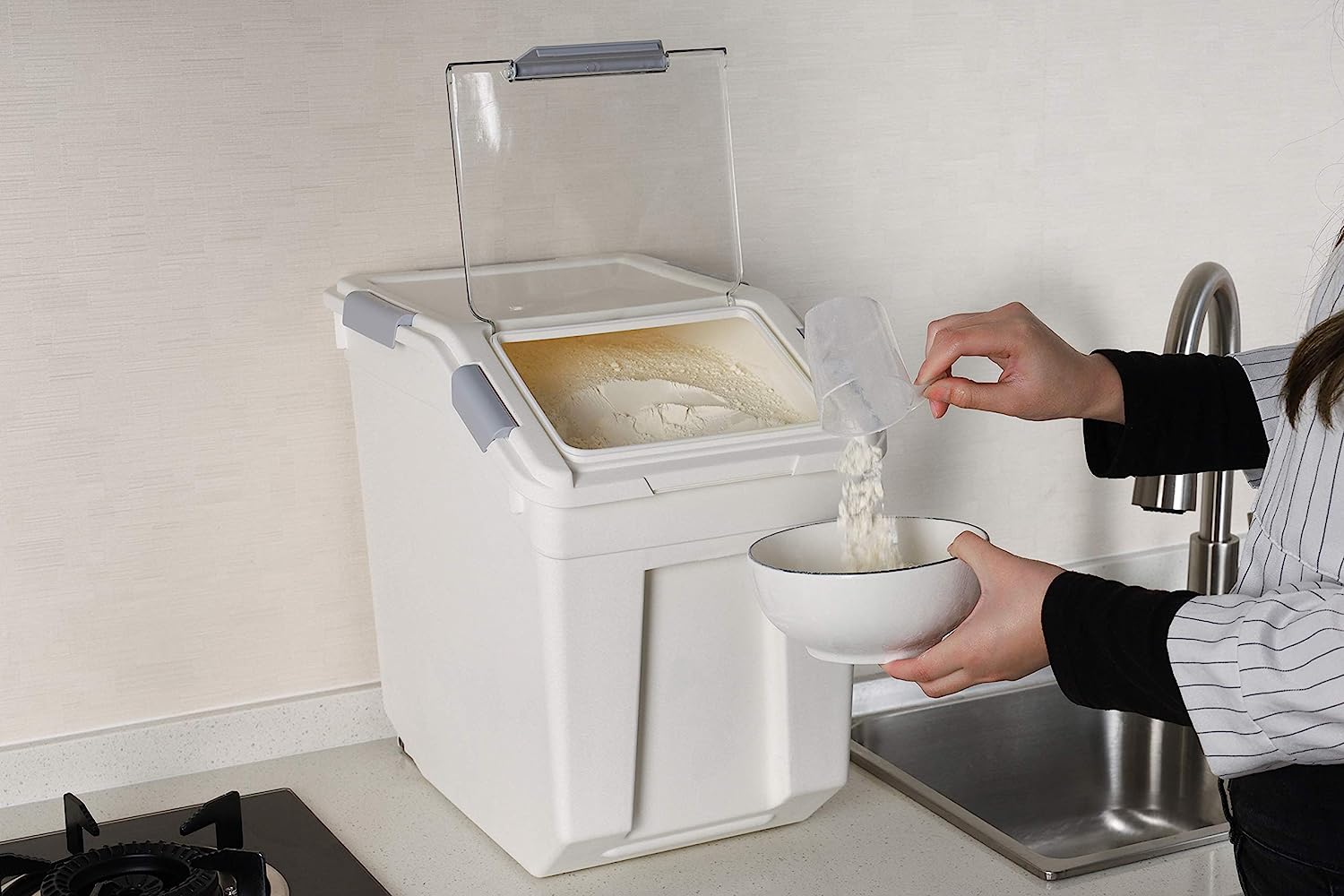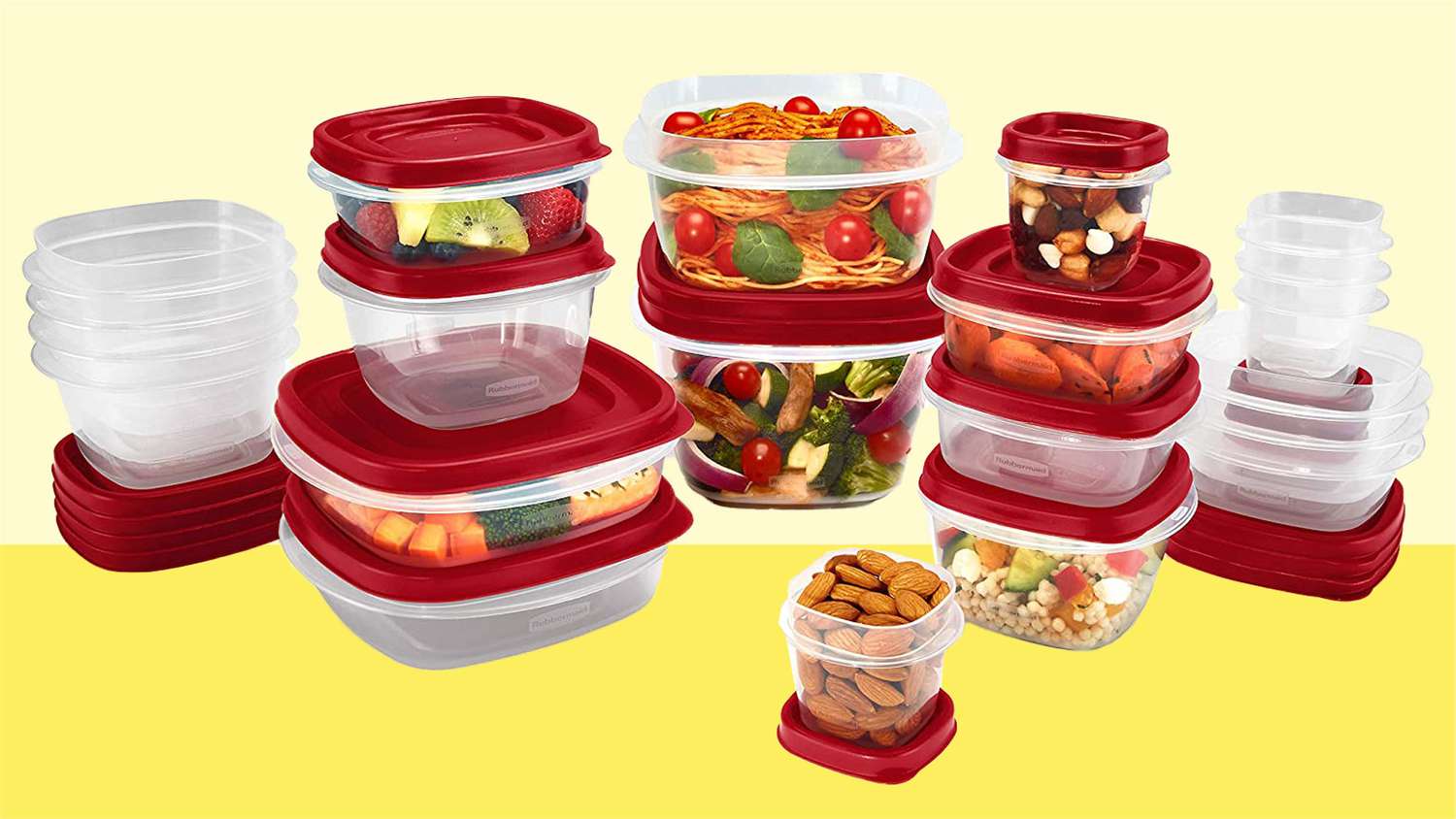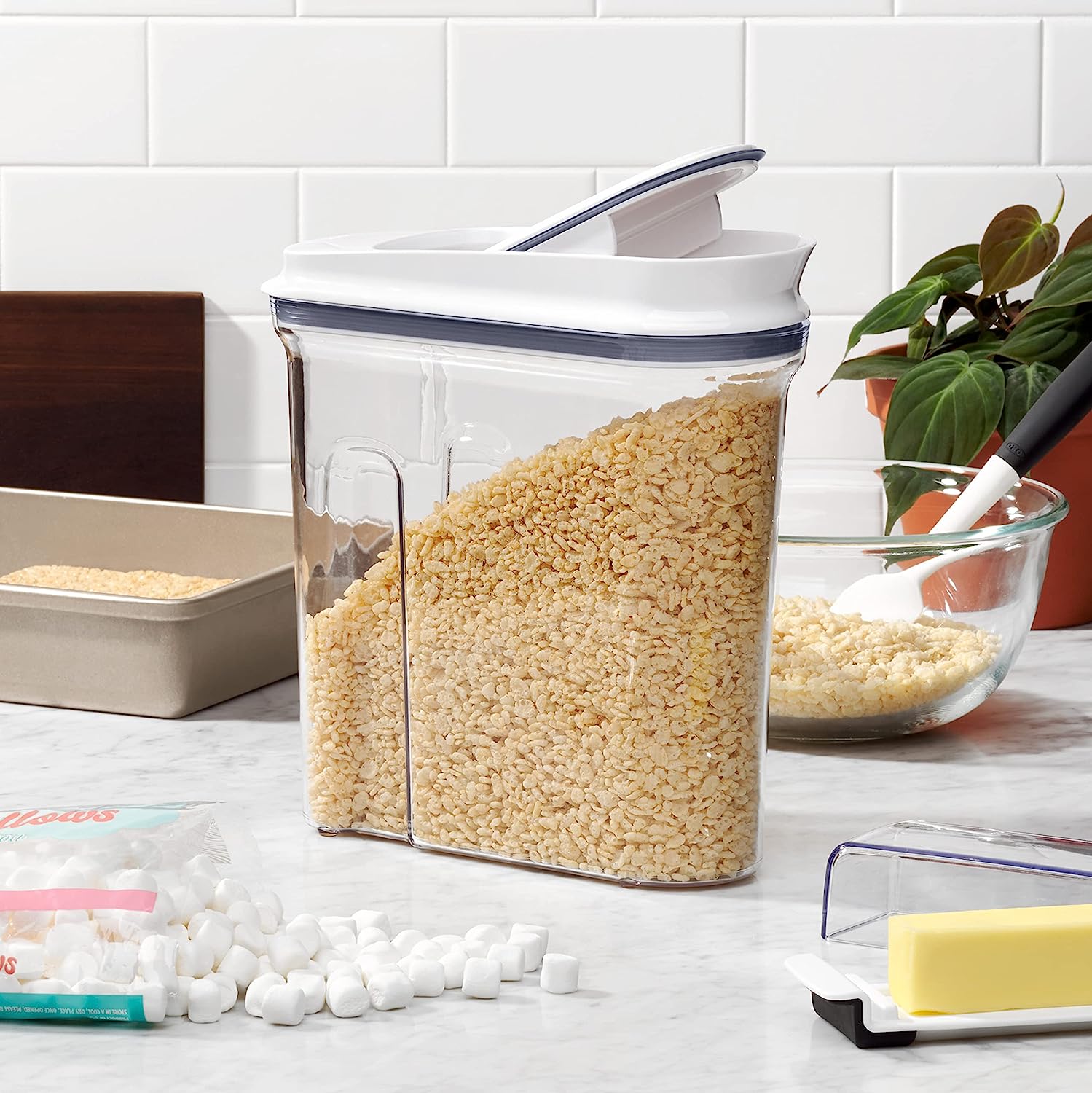

Articles
What Are Airtight Containers
Modified: January 19, 2024
Looking for storage ideas? Discover the benefits of airtight containers for keeping your belongings organized and protected. Find the best options for your needs today!
(Many of the links in this article redirect to a specific reviewed product. Your purchase of these products through affiliate links helps to generate commission for Storables.com, at no extra cost. Learn more)
Introduction
Welcome to the world of airtight containers – the unsung heroes of kitchen organization and food storage! If you’ve ever found yourself struggling to keep your pantry organized or dealing with stale snacks, it’s time to consider the benefits of airtight containers. These innovative storage solutions not only keep your food fresh for longer but also help maintain its quality, taste, and texture.
Airtight containers are designed to create a seal that prevents air and moisture from entering and escaping. This airtight seal is what sets these containers apart from ordinary storage options, making them ideal for keeping a variety of dry goods, pantry staples, and even leftovers fresh for extended periods.
In this article, we will explore the different types of airtight containers available, their key features, and how to properly use and care for them. We will also discuss the benefits of using airtight containers and common mistakes to avoid. Whether you’re a seasoned home cook or someone looking to declutter and organize their kitchen, airtight containers are a game-changer.
But before we dive into all the details, let’s start by understanding what exactly airtight containers are and why they are so beneficial for everyday use.
Key Takeaways:
- Airtight containers are essential for preserving food freshness, extending shelf life, and maximizing storage space. They offer versatile benefits, from preventing spoilage to organizing kitchen essentials and beyond.
- Choosing high-quality airtight containers with reliable seals and proper care ensures long-lasting functionality. Avoid common mistakes like overfilling, neglecting cleaning, and using damaged seals to maximize the effectiveness of these versatile storage solutions.
Read also: 14 Best Airtight Storage Containers For 2024
Definition of Airtight Containers
Airtight containers, as the name suggests, are containers designed to create a seal that keeps air and moisture out, preserving the freshness and quality of the contents inside. These containers are typically made from durable materials such as plastic, glass, or metal, and feature airtight lids or closures that form a tight seal when properly secured.
The primary purpose of airtight containers is to prevent oxygen and moisture from entering the container and coming into contact with the stored food or other items. Oxidation and moisture can accelerate the spoilage process, leading to the growth of bacteria, mold, and mildew.
By creating an airtight seal, these containers effectively block out external factors that can compromise the integrity and freshness of the contents. They are particularly beneficial for storing dry goods such as flour, sugar, cereals, nuts, and coffee beans, as well as perishable items like leftovers, fruits, and vegetables.
Additionally, airtight containers can also be used to store non-food items such as medicines, herbs, spices, pet food, and even small household items. Their versatility and ability to maintain optimal conditions make them an essential addition to any kitchen or storage space.
It is important to note that not all containers marketed as “airtight” are truly airtight. Some may have a degree of airflow or may not provide a complete seal. It is advisable to look for containers that have been specifically designed and tested for airtightness.
Now that we have a clear understanding of what airtight containers are, let’s explore the various benefits they offer in terms of food preservation and storage efficiency.
Benefits of Airtight Containers
Airtight containers offer a range of benefits that make them indispensable in the kitchen and beyond. Let’s explore some of the key advantages they provide:
1. Freshness and Preservation:
The primary benefit of airtight containers is their ability to keep food fresh for longer periods. By creating an airtight seal, these containers prevent air and moisture from entering, reducing the risk of spoilage and preserving the taste, texture, and nutritional value of the stored items. Whether it’s preventing dry goods from going stale or keeping leftovers tasting their best, airtight containers are essential for maintaining freshness.
2. Extended Shelf Life:
When food is exposed to air, it undergoes oxidation, which can lead to rancidity and spoilage. Airtight containers minimize exposure to oxygen, helping to extend the shelf life of perishable items and reducing waste. This is especially beneficial for items like bread, cookies, and snacks that are prone to becoming stale quickly.
3. Organization and Space Efficiency:
Airtight containers offer excellent organizational benefits. With their uniform shapes and stackable design, they maximize storage space and help keep your pantry, refrigerator, or countertop neat and clutter-free. Clear containers also allow you to easily identify the contents at a glance, making it easier to keep track of your supplies and prevent food waste.
4. Protection against Pests:
For pantry staples like grains, cereals, and spices, airtight containers act as a barrier against pests such as ants, weevils, and pantry moths. These unwanted intruders are unable to penetrate the sealed containers, ensuring the safety and hygiene of your stored goods.
5. Portable and Convenient:
Airtight containers are designed to be portable, making them convenient for meal prep, picnics, lunches, or on-the-go snacks. They prevent leaks and spills, keeping your food fresh and contained without the need for plastic wrap or disposable containers, reducing waste and environmental impact.
6. Versatility:
While airtight containers are commonly used for storing food, they can also be utilized for various non-food items. They are ideal for keeping medications, vitamins, herbs, and spices fresh and protected. Additionally, airtight containers can be used for organizing craft supplies, small tools, and even as travel containers for toiletries.
With these numerous benefits, airtight containers are a valuable investment for anyone looking to optimize their food storage, minimize waste, and maintain a well-organized kitchen.
Different Types of Airtight Containers
When it comes to airtight containers, there are several options available on the market. Each type of container has its own unique features and advantages. Let’s explore some of the most common types of airtight containers:
1. Plastic Containers:
Plastic airtight containers are popular due to their lightweight and durable nature. They are available in various shapes and sizes, including rectangular, square, and cylindrical. Many plastic containers have snap-on lids with silicone gaskets, providing a secure and airtight seal. These containers are often transparent, allowing for easy visibility of the contents inside.
2. Glass Containers:
Glass airtight containers are another popular choice for many reasons. They are non-toxic, BPA-free, and do not absorb odors or flavors. Glass containers are ideal for storing both dry goods and liquids. They often come with airtight lids that have a silicone or rubber gasket. Glass containers are also oven-safe, making them convenient for reheating or cooking in the oven.
3. Metal Containers:
Metal airtight containers, typically made from stainless steel, offer durability and a sleek design. These containers are resistant to corrosion and can withstand extreme temperatures. Metal containers usually have airtight lids with silicone gaskets, ensuring a tight seal. They are commonly used for storing coffee beans, tea leaves, and spices.
4. Vacuum-Sealed Containers:
As the name suggests, vacuum-sealed containers use a vacuum pump or electric sealing mechanism to remove air from the container, creating an airtight environment. These containers are perfect for preserving the freshness of perishable items, such as fruits, vegetables, and sous vide cooked meals.
5. Silicone Bags and Pouches:
Silicone bags and pouches are a reusable and eco-friendly alternative to traditional airtight containers. These bags feature airtight seals and are perfect for storing snacks, sandwiches, and liquids. They are lightweight, easy to clean, and can be folded or stacked for convenient storage.
6. Mason Jars:
Mason jars, typically used for canning, can also serve as airtight containers. They feature a two-piece lid system with a metal screw-on band and a flat lid with a rubber gasket. Mason jars are great for storing jams, pickles, sauces, and dry goods like grains and spices.
These are just a few examples of the different types of airtight containers available. The choice ultimately depends on personal preferences, storage needs, and the types of items you plan to store. Regardless of the type you choose, airtight containers provide an effective solution for keeping your food fresh and organized.
Key Features to Consider when Choosing Airtight Containers
When selecting airtight containers, there are several important features to consider to ensure you choose the right ones for your needs. Here are some key factors to keep in mind:
Read also: 11 Best Silicone Food Storage For 2024
1. Quality and Durability:
Opt for airtight containers made from high-quality materials that are built to last. Look for containers that are sturdy, resistant to cracking and warping, and are safe for use with food. Checking customer reviews and ratings can help you gauge the quality and durability of the containers.
2. Airtight Seal:
The primary purpose of airtight containers is to create a seal that keeps air and moisture out. Ensure that the containers you choose have a reliable airtight seal. Look for lids or closures with silicone gaskets, as these provide a tight and secure seal, preventing any leaks or spills.
3. Transparent Design:
Having a transparent or clear design allows you to easily see the contents of the containers without having to open them. This makes it easier to identify what you have and helps prevent food waste. Clear containers also make for a visually appealing and organized pantry or refrigerator.
4. Stackability:
Airtight containers that are stackable are a great space-saving feature. They allow you to maximize storage space, especially in small kitchens or pantries. Look for containers with a uniform shape and size that easily stack together without toppling over.
5. Versatile Sizes and Shapes:
Consider your storage needs and the types of items you plan to store. Opt for containers that come in a variety of sizes and shapes to accommodate different types of food. It’s helpful to have different-sized containers for storing small quantities as well as larger ones for bulk storage.
6. Microwave and Dishwasher Safe:
If you plan to use your airtight containers for reheating or storing leftovers, make sure they are microwave-safe. Additionally, dishwasher-safe containers make cleaning a breeze and ensure proper sanitation.
7. BPA-Free and Food-Grade:
Choose containers that are free from harmful chemicals like BPA (bisphenol A) and that are designated as food-grade. These containers are safe for storing food and do not leach harmful substances into your stored items.
By considering these key features, you can make an informed choice when selecting airtight containers that best meet your needs. Remember that investing in high-quality containers with reliable seals is crucial for effective food storage and preservation.
Proper Usage and Care of Airtight Containers
To get the most out of your airtight containers and ensure their longevity, it’s essential to understand proper usage and care. By following these guidelines, you can maintain the freshness, integrity, and functionality of your containers:
Read also: 14 Best Food Storage Containers For 2024
1. Clean Before First Use:
Wash your airtight containers with warm, soapy water before using them for the first time. This will remove any dust, debris, or residue from the manufacturing process. Rinse them thoroughly and allow them to dry completely.
2. Check the Seal:
Prior to storing any food items, always check the seal of the container. Ensure that the lid or closure is properly aligned and securely tightened to create an airtight seal. This step is crucial to maintain the freshness and integrity of the contents.
3. Avoid Overfilling:
Avoid overfilling the containers as this can put pressure on the seal and compromise its effectiveness. Leave some space at the top to allow for any expansion that may occur, especially when freezing liquids.
4. Store in a Cool, Dry Place:
Store your airtight containers in a cool, dry place away from direct sunlight. Exposure to heat and sunlight can degrade the quality of the container material and compromise the airtight seal. It’s also important to keep them away from sources of moisture, such as sinks or dishwashers.
Read also: 12 Best Food Storage Container Set For 2024
5. Avoid Extreme Temperatures:
Avoid subjecting your airtight containers to extreme temperatures, as this can damage them. For example, freezing plastic containers may cause them to become brittle and crack. Similarly, subjecting glass containers to sudden temperature changes can lead to breakage. Check the manufacturer’s instructions for temperature limitations specific to your containers.
6. Handwash or Follow Cleaning Instructions:
Most airtight containers are dishwasher-safe, but to prolong their lifespan, it’s recommended to handwash them. Use mild dish soap and warm water to clean the containers, and avoid using abrasive sponges or brushes that can scratch the surface. Dry them thoroughly before storing or using them again.
7. Regular Maintenance:
Regularly inspect your airtight containers for any signs of wear or damage. Check the seals for cracks, tears, or degradation, and replace them if needed. It’s also a good idea to periodically clean and sanitize your containers, especially if you use them for storing different types of food.
By following these proper usage and care guidelines, you can ensure that your airtight containers maintain their functionality, freshness, and durability for a long time. Remember, a little maintenance goes a long way in keeping your food storage organized and your food items in their best condition.
Common Mistakes to Avoid with Airtight Containers
While airtight containers are incredibly useful for storing food and keeping it fresh, there are some common mistakes that people often make. By avoiding these mistakes, you can maximize the benefits and effectiveness of your airtight containers:
1. Overlooking Proper Cleaning:
One common mistake is neglecting to clean the containers thoroughly before each use. Failing to remove any residue or odors can affect the taste and quality of the stored food. Take the time to wash and dry your containers properly to ensure optimal hygiene.
2. Using Containers with Damaged Seals:
Continuing to use airtight containers with damaged or degraded seals can compromise their ability to keep the contents fresh. It’s essential to regularly inspect the seals for cracks, tears, or signs of wear and replace them promptly to maintain an airtight environment.
3. Filling Containers to the Brim:
Filling your airtight containers to the brim with food can put pressure on the seal and reduce its effectiveness. Leave some space at the top to allow for any expansion, especially when dealing with liquids or when freezing items.
4. Storing Moist or Hot Food:
Avoid storing hot, freshly cooked food directly into airtight containers. The trapped heat and moisture can create a steamy environment that promotes bacterial growth. Allow the food to cool down before transferring it to prevent any condensation from forming inside the container.
5. Overexposure to Sunlight:
Exposing airtight containers to direct sunlight can accelerate the degradation of the container material and affect the effectiveness of the seal. Store your containers in a cool, dry area away from direct sunlight to preserve their quality and integrity.
6. Neglecting Proper Storage:
Improper storage practices, such as stacking heavy items on top of airtight containers, can cause them to crack or break. Be mindful of how you arrange and store your containers to prevent unnecessary damage.
7. Using Incorrect Containers for Specific Foods:
Not all airtight containers are suitable for all types of food. Certain foods, such as acidic or oily ones, may react with certain materials. It is important to choose containers made of appropriate materials, like glass or stainless steel, when storing such foods to maintain their quality and prevent any chemical reactions.
By avoiding these common mistakes, you can ensure that your airtight containers continue to be effective in preserving the freshness and quality of your stored food. Paying attention to proper cleaning, maintenance, and storage practices will help you make the most of your airtight containers for years to come.
Alternative Uses for Airtight Containers
While airtight containers are primarily designed for storing food, their versatility extends beyond the kitchen. Here are some alternative uses for airtight containers that can help you stay organized and efficient:
1. Organization in the Bathroom:
Airtight containers can be excellent storage solutions for bathroom essentials. Use them to store cotton balls, swabs, makeup brushes, and other small items. Their airtight seal will help keep these items clean, dry, and easily accessible.
2. Travel Companions:
Airtight containers are perfect for travel purposes. Use them to store travel-sized toiletries, keeping them leak-free and organized in your suitcase. They are also great for storing snacks, preventing them from getting crushed or stale during your journey.
3. Craft and Hobby Supplies:
Airtight containers can keep your craft and hobby supplies organized and protected. Use them to store small items like beads, buttons, ribbons, or even paintbrushes. The airtight seal will prevent these items from getting lost or damaged.
4. Garage or Tool Shed Organization:
Keep your tools and garage supplies tidy and accessible by utilizing airtight containers. They can house small hardware items like screws, nails, nuts, and bolts, ensuring they remain organized and protected from moisture and rust.
5. First Aid Kit:
Create a compact and portable first aid kit using airtight containers. Store bandages, ointments, medications, and other essential supplies in these containers to keep them clean, secure, and readily available during emergencies.
6. Pet Food Storage:
Airtight containers are ideal for storing pet food, keeping it fresh and protected from pests. Ensure that the containers are specifically designed for pet food storage and are made of food-grade materials.
7. Seed Storage:
If you’re an avid gardener, airtight containers can help you store and organize seeds. Keep your collection of flower, herb, or vegetable seeds in separate containers, protecting them from moisture, pests, and deterioration.
8. Office Supplies Organization:
Streamline your office space by using airtight containers to store and organize small office supplies like paperclips, push pins, rubber bands, or staples. The airtight seal will keep these items secure and easily accessible.
These alternative uses for airtight containers demonstrate their versatility beyond the kitchen. By repurposing them for various needs, you can stay organized, protect your belongings, and make the most of these functional storage solutions.
Conclusion
Airtight containers are an essential tool for keeping your food fresh, organized, and protected from moisture, air, and pests. With their ability to create a tight seal, these containers preserve the quality, taste, and texture of your stored items, extending their shelf life and reducing waste.
In this article, we explored the various benefits of airtight containers, including their ability to maintain freshness, prevent spoilage, and maximize storage space. We discussed different types of airtight containers, such as plastic, glass, metal, and vacuum-sealed options, each with their own advantages and functionalities.
When choosing airtight containers, it’s important to consider factors such as quality, airtight seal, transparency, stackability, versatility, and compatibility with various environments like the microwave or dishwasher. By paying attention to these features, you can find the containers that best suit your storage needs and preferences.
We also covered proper usage and care guidelines to ensure the optimum performance and longevity of your airtight containers. From cleaning them before first use to avoiding common mistakes like overfilling or exposure to sunlight, following these guidelines will help you make the most of your containers.
Moreover, we discussed alternative uses for airtight containers beyond the kitchen, such as organizing bathroom supplies, creating travel-sized kits, storing craft and hobby materials, and keeping your garage or office supplies organized.
In conclusion, airtight containers are an invaluable asset in any household, providing a simple and effective solution for storing food and other items. With their ability to maintain freshness, promote organization, and prevent waste, these containers help optimize your kitchen space and make your daily life more convenient.
Investing in high-quality, airtight containers is a wise choice to preserve the quality and freshness of your stored items for extended periods. So, whether you’re a home cook, an organizer, or someone looking to simplify their storage methods, airtight containers are a reliable solution that you won’t regret incorporating into your daily routine.
Frequently Asked Questions about What Are Airtight Containers
Was this page helpful?
At Storables.com, we guarantee accurate and reliable information. Our content, validated by Expert Board Contributors, is crafted following stringent Editorial Policies. We're committed to providing you with well-researched, expert-backed insights for all your informational needs.




0 thoughts on “What Are Airtight Containers”